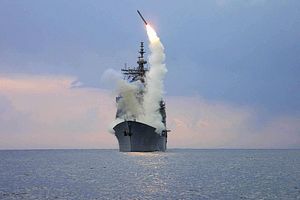Earlier this week, Russia stepped up its military operations in Syria by launching a volley of land attack cruise missiles (LACMs) against Syrian opposition fighters. This type of attack, similar to a multitude of attacks by the United States, represents the culmination of several political and technological trends, and could herald a moment that many analysts have suggested is a long time in coming: the diffusion of precision LACMs across the international system.
Reports indicate that the Russian (apparently 3M-54 “Klub”) missiles were fired from two missile boats operating in the Caspian Sea, meaning that they needed to travel over a thousand miles of Iranian, Iraqi, and Syrian territory before striking their targets. Launching the missiles from the Caspian may have allowed Russia to avoid problems with the INF Treaty, which restricts development of ground launched cruise missiles.
LACMs, whether launched from ships, aircraft, or ground installations, face different obstacles than their anti-ship cousins. LACMs need to navigate complex land terrain, avoid air defenses, and figure out how to differentiate their targets from the rest of the landscape. Thus, using LACMs means overcoming fairly intense communication, data, and processing problems. This is one reason why, despite the spread of basic cruise missile technology around the world, very few states have successfully integrated LACMs into their arsenals.
In the form of the Tomahawk, LACMs have provided one of the foundations of American military dominance since the first Gulf War. Launched from submarines and surface ships, Tomahawks have enabled the U.S. to project power around the world, whether or not it has aircraft available. Moreover, LACMs have allowed the US to “kick in the door” of anti-access air defense networks, reducing the danger to American planes and pilots.
The cruise missile attacks don’t add anything in particular to Russia’s capabilities in Syria; although Russian aircraft lack the precision munitions of their Western counterparts, they can still conduct the kind of strikes, in uncontested airspace, that the LACMs are supposed to replace. Rather, the attacks represent a test of concept for the Russians, demonstrating to themselves and others that they can fire precision LACMs from long distance. That the missiles had to cross Iranian and Iraqi airspace helps even more, as it demonstrates Russia’s political power in the region.
The missiles themselves came from two types of Russian surface vessel, the 1500 ton Gepard class frigate, and the 500 ton Buyan class corvette. Russia has already exported both types, with six Gepards on their way to Vietnam to form the core of the surface flotilla of the Vietnam People’s Navy. Russia has also exported several versions of the 3M-54 “Klub”cruise missile, although almost all of these are intended for anti-ship usage.
While some have argued that the attack represents a sales pitch to potential LACM customers, Russia may be reluctant to sell such capabilities to just anyone. In particular, Beijing might resent the export of LACMs to countries like Vietnam, which would undoubtedly plan to use them against Chinese targets. Moreover, while the data and communications requirements necessary to successfully fielding such systems have become more surmountable, it’s still easier for a country like Russia to use them than for a country like Vietnam.
Still, people are watching. Russia’s innovative use of Caspian seapower will almost certainly generate greater interest in LACMs in the near future, with potentially significant consenquences for how big countries relate to mid-sized powers.
































